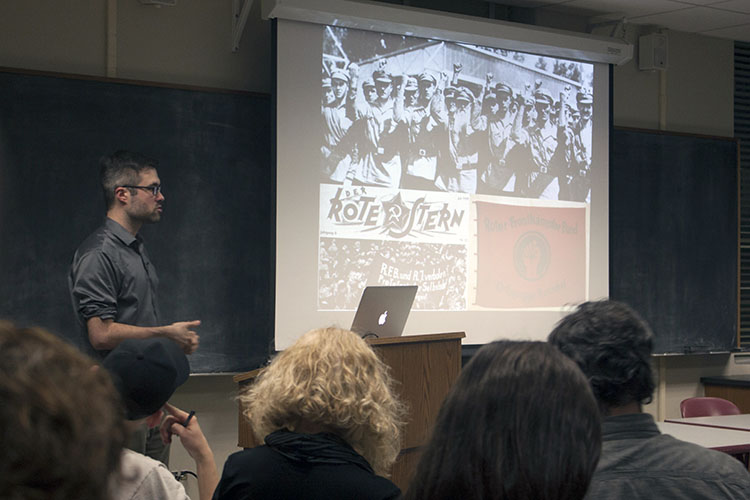Campus speaker: Who is Antifa, anyway?
A scholar of the movement explains what he's learned.
November 14, 2017

Mark Bray, an adjunct professor of history at Dartmouth College and author of Antifa: The Anti-Fascist Handbook, speaks at UC Berkeley on Monday, Nov. 13. (UC Berkeley photo by Thomas Texeira)
The tactics of American antifascist protesters have a long history that is inextricably connected to the anti-Nazi and anti-racist movements of Europe, an expert on the group told a crowded room in UC Berkeley’s Dwinelle Hall Monday evening.
“Antifascism is a very informed historical tradition,” said Mark Bray, an adjunct professor of history at Dartmouth College and author of Antifa: The Anti-Fascist Handbook, a new book tracing the origins and philosophies of the leaderless, horizontal movement.
The talk was sponsored by the Department of Spanish and Portuguese, and comes less than a year after antifascist, sometimes called antifa, protesters destroyed property and lit fires on the Berkeley campus before a February talk by right-wing YouTube personality Milo Yiannopoulos. Police cancelled Yiannopoulos’s appearance, calling the demonstrations against him an “organized violent attack.”
Bray’s talk also comes during Berkeley’s “Free Speech Year,” when campus leaders have promised to engage in broad and searching debate about contemporary political discourse. Earlier this month, a conservative thinker urged students and administrators to find “warmth in their heart” for new ideas.
Bray, 35, who is also a former Occupy Wall Street organizer, urged listeners to avoid dismissing antifa protesters as renegades set on committing violence for the sake of destruction, despite how they are portrayed in the media.
In interviews with antifascists, some via encrypted chat, Bray said he came to understand that antifascist demonstrators see violence as a tool to halt the spread of totalitarian, racist ideas and to defend those who could be victims of such regimes.
In particular, he pointed to the Battle of Cable Street, a 1936 riot in London where 20,000 anti-fascist demonstrators confronted some 3,000 fascist marchers. The fascists were forced to retreat, while the antifascists stayed to fight with police. The battle is often cited by contemporary antifa protesters, Bray said.
Antifascists also want to stop any fascist movement before it can grow, even if those they target appear small and inconsequential, said Bray, who is also a scholar of early 20th century Spanish radicalism.
As an example, Bray, who was criticized earlier this year for appearing to condone violent protest when he talked about antifa, noted that there were 54 people in what became the Nazi Party when Hitler joined and just 100 in Mussolini’s original “fascist nucleus.”
“Post-war antifascists have argued that you should treat every small fascist group as if they could be Hitler’s 54 or Mussolini’s 100, recognizing that most of them won’t be, possibly none of them would be, but if even one of them is, then it is worth shutting it down from the beginning,” Bray said. “It is not always so clear when things have gotten bad enough to not defend ourselves, therefore antifascists argue that you don’t let fascist or white supremacist organizing take even the first step.”

The standing-room only crowd at the event. (UC Berkeley photo by Thomas Texeira)
But how do you define a fascist? That’s more complicated, according to those who spoke up at Bray’s talk.
During a question-and-answer session, Naweed Tahmas, a political science major and member of the college Republican club that invited Yiannopoulos in February, said that he had since been unfairly targeted by antifa demonstrators, who made him into a caricature of right-wing beliefs.
“I’m not intimidating anyone, but to these groups I am seen as a boogeyman,” Tahmas said. “I am just wondering if you think it is appropriate for these groups to attack anyone they perceive as being a Nazi or seem to be a white supremacist?”
Bray said Tahmas and conservatives like him should avoid confusion by repudiating the language and philosophies of alt-right fascists.
“There’s a lot of muddied waters,” Bray said. “It is important for Republicans and conservatives to say that (fascists) are not welcome.”
Antifascists too have a complicated appreciation for free speech, Bray said. The group has often been criticized for using intimidation to avoid media coverage and stop right-wing speakers and demonstrations.
“I got two main kinds of answers from the people that I spoke to,” Bray said. “The first was those who denied that anti-fascism is anti-free-speech by arguing sort of essentially that they’re not the government, they’re not trying to censor anyone.”
The second group argues that by stopping alt-right fascists from speaking, antifascists seek to make free speech more fundamentally fair, Bray said.
“The liberal state has these formal rights but in practice, because of capitalism, they don’t actually play out,” Bray said, explaining the antifa argument.
“If you take a sort of anti-racist interpretation of free speech and say ‘Ok, what are the practical effects of having white supremacy organizing in a community?’ Does that foster a situation where all individuals regardless of their race, religion or national origin feel comfortable participating equally in the public discourse?” he asked.
How effective antifa protests are can remain up for debate, Bray said. But the discussion shouldn’t distract from a focus on stopping politics that alienate and exclude, he believes.
“For me it is not just a question of what the far-right does, but do we have, as an anti-racist movement, the organizational chops and power to organize and resist,” Bray said.
Contact Will Kane at [email protected]